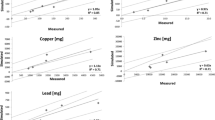Abstract
A new approach using input-output techniques is proposed for the analysis of urban stormwater pollution caused by urban land development. The input-output model provides projections of sectoral outputs within an urban region. By defining land as an input to production, these output projections may be translated into projections of commercial and industrial land development. Furthermore, the ‘closed’ version of the input-output model is used to project residential land development as a function of projected wage income. The pollutant generation in urban stormwater is related to the quantity of each category of land development by a pollutant coefficient matrix. Thus, the model can be used to predict the impact of various economic growth scenarios on pollution loadings in runoff water. This will help planners in assessing the environmental costs of various scenarios, and in preparing for remedial actions. A numerical example is provided to illustrate the applications of the model.
Similar content being viewed by others
References
Beyers, W. B., 1972, On the stability of regional interindustry models: the Washington economy data for 1963 and 1967,J. Regional Sci. 12, 363–374.
Chen, K., 1973, Input-output economic analysis of environmental impact,IEEE Trans. Systems, Man, Cybernet. SMC-3, (6), 539–547.
Conference Board of Canada, 1990.Economic Linkages between the Northwest Territories and the Rest of Canada, Special Economic Services Group, Ottawa.
Duchin, F., 1989, An input-output approach to analyzing the future economic implications at technological change, in R. E. Miller, K. R. Polenske, and A. S. Rose (eds),Frontiers in Input-Output Analysis, Oxford University Press, New York.
Ellis, J. B., 1986, Pollutional aspects of urban runoff, in Torno et al. (eds),Urban Runoff Pollution, Springer-Verlag, Berlin Heidelberg, pp. 1–38.
Giarrantani, F., 1974, Air pollution abatement: output and relative price effects, a regional input-output simulation,Environ. Plan. A 6, 307–312.
Grigg, N. S., 1986,Urban Water Infrastructure: Planning, Management and Operations, Wiley, New York.
International Joint Commission, 1982, Report on Great Lakes water, quality, Windsor, Ontario.
Ketkar, K. W., 1983, Pollution control and inputs to production,J. Environ. Econom. Manage. 10, 50–59.
Lawrence, A. I. and Goyen, A. G., 1987, Improving urban stormwater quality — an Australian strategy in W. Gujer and V. Krejci (eds),Topics in Urban Storm Water Quality, Planning and Management, Proc. IV Conf. on Urban Storm Drainage, Lausanne, Aug. 31 – Sept. 4, 1987, pp. 129–134.
Leontief, W., 1970, Environmental repercussions and the economic structure: an input-output approach,Rev. Econom. Statistics,52 (3), 262.
Lonergan, S. C., and Cocklin C., 1985, The use of input-output analysis in environmental planning,J. Environ. Manage. 20, 129–147.
Marsalek, J., 1978,Pollution Due to Urban Runoff: Unit Loads and Abatement Measures, International Joint Commission, Windsor, Canada.
Marsalek, J. and Ng, H.Y.F., 1989, Evaluation of pollution loadings from urban nonpoint sources: Methodology and applications,J. Great Lakes Res. 15(3), 444–451.
Miernyk, W. H., 1970,Simulating Regional Economic Development: An Interindustry Analysis of the West Virginia Economy, Lexington Books, Lexington MA.
Miernyk, W. H., 1973, A regional input-output pollution abatement model,IEEE Trans. Systems Man Cybernet. SMC-3, 575–577.
Miller, R. E. and Blair, P. D., 1985,Input-Output Analysis Foundations and Extensions, Prentice-Hall, Englewood Cliffs, N. Jer.
Oosterharen, J., 1980, Review of Dutch regional input-output analysis,Ann. Regional Sci. 14, 6–14.
Rhee, J. J. and Mirankowski, J. A., 1984, Determination of income, production, and employment under pollution control: An input-output approach,Rev. Econom. Statistics. 66, 146–150.
U. S. Environmental Protection Agency (EPA), 1983,Results of the Nationwide Urban Runoff Program, Volume I, Final Report, Water Planning Division, U.S. Environmental Protection Agency, NTIS No. PB84-185552, Washington, D.C.
Victor, P. A., 1972,Pollution: Economy and Environment, Allen and Unwin, London.
Xu, P., 1992, A planning-level model for calculation of toxic pollutant loadings in urban runoff, M. Eng Thesis, Department of Civil Engineering, McMaster University, Hamilton, Ontario, Canada.
Author information
Authors and Affiliations
Rights and permissions
About this article
Cite this article
Xu, P., Tsanis, I.K., Anderson, W.P. et al. An economic input-output analysis for urban stormwater quality planning. Water Resour Manage 8, 155–170 (1994). https://doi.org/10.1007/BF00872434
Received:
Accepted:
Issue Date:
DOI: https://doi.org/10.1007/BF00872434




